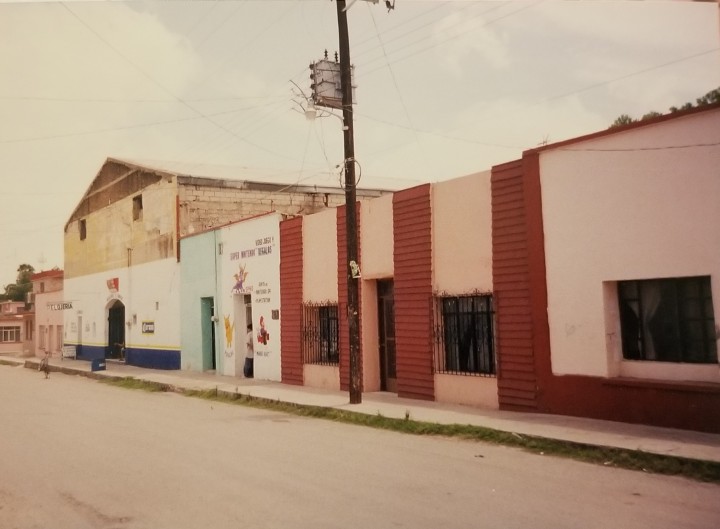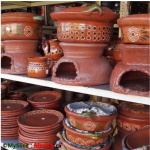
My arrival in Mexico was filled with great sadness; my mom had passed away. She was resting peacefully at the funeral home, dressed in the elegant ensemble that she had worn to two family weddings. Dear family, caring friends, and beautiful flowers kept pouring in at the visitation hall throughout the evening, and a simple service the next morning was the last rite before our final goodbye. Although still trying to process what has happened, I am definitely grateful for some happy moments shared just a few weeks back, when I came to visit and to attend my niece’s wedding.
In this and a few future posts, I would like to share some of my mom’s stories and recipes from her childhood in Agujita, a small mining town in the Mexican state of Coahuila; when I myself was a child, I heard these and many other anecdotes, sitting with my mom in her kitchen, which filled my imagination with picturesque scenes of Mexico (and other countries) and inspired me to always strive to move forward, and never stop learning. Thank you, mom!
In 1906, my grandfather arrived in Palaú, Coahuila, to work in the coal mines; this was near the end of one of the largest Japanese migrations to Mexico. After the Mexican Revolution War (1910-1921), in which he lost a plot of land he had bought with his savings, he moved to Agujita (present time photo at the top of this post), where he started again from zero, working at a general store. A few years later, he had managed to save enough to open his own. My grandmother arrived from Japan in 1926, already married to my grandfather in absentia, and my mother was born a year later. After a while, they opened a bigger store on calle Comercio (Trade Street). The original structure had a storage room next to the store front, with a few rooms and a yard behind, where my mom’s family lived. A view of the same spot, in the photo below, shows the current structure, just a plain house with a front door and window:

Esthercita (Little Esther, my mom’s nickname) was active and very independent from a young age, known to walk herself to a neighbour’s house when she was three years old, carrying a packed meal and a couple of small bags of raw rice and beans from her parents’ store; the prepared food was her lunch, and the rest was for the neighbour, as payment for babysitting her while both her mom and dad worked.
My mom always loved sweets, and her favourite dessert was Capirotada, a bread pudding with cheese, which she remembered since her childhood as a traditional dish her mother often cooked. My mom made it sometimes when I was growing up, especially during Lent, and I have introduced it to my daughters, the fourth generation to enjoy my grandmother’s recipe, as it was prepared in my mom’s hometown.
Agujita Style Bread Pudding – Capirotada estilo Agujita
Click here for detailed description and photos
Click here for printable recipe








Querida Irene, siento mucho oir del fallecimiento de tu mamá, te acompaño en tu pena y la de tu familia. Como siempre le haces honor a tu mamá llevando sus historias a tus lectores y manteniendo vivas las tradiciones con sus recetas. Krysia
LikeLiked by 1 person
Gracias, amiga!
LikeLike
Irene,
I’m so sad to hear about your loss. It sounds like it may have been sudden and unexpected.
I was not aware of your Japanese heritage until now – your posts are so thoroughly Mexican-themed. Very interesting story.
LikeLike
Thank you, Eilene!
LikeLiked by 1 person
Thank you again for your kind comment, Eilene. I am grateful that I had seen my mom just two weeks before her passing; she was frail and recovering from a hospital stay, but managed to go out for brunch a couple of times, so at her 92 years of age, it was unexpectedly sudden (cardiac arrest), but not completely unexpected, and she was in her bed at home when it happened, so that was a blessing.
My dad was Japanese, too, so my ancestry is mostly from there, but I was born and raised in Mexico and have not been to Japan yet, so my life experiences are Mexican/Canadian, infused with a lot of Japanese anecdotes and background.
LikeLiked by 2 people
I’m glad your mom had a long life with lots of love. She seems to have passed on many blessings to her children.
LikeLiked by 1 person
Absolutely, thank you, Eilene!
LikeLiked by 1 person
It’s hard to know the right thing to say really. It’s hard to lose your mom. The feelings will come and go in waves. The funeral with her friends and her family sounded comforting to be with them and know that they loved her too. She sounded pretty cool as a child — it’s not every kid who brings their babysitter their payment and she was doing it at 3. Your family history is very interesting too. Thank you for sharing.
LikeLike
It is hard; I appreciate so much to hear about the feelings, so I am reassured that it is ok to feel up or/and down, and also treasure them all as part of the process. I always enjoyed hearing her “slice of life” adventures, and it felt right to share a few. Thank you so much for your kind words, Mary!
LikeLiked by 1 person
I enjoy reading about her. Fits with the way your blog is — recipes as food as well as the interweaving of family, history and culture. You might find people bringing up the 5 stages of grief like it’s a set thing — I think it more defines the major emotions/mindsets that happen but the stages don’t necessarily happen quite sequentially. They overlap a lot. And sadness hits more later when the busyness of the funeral time passes, and you have more quiet time. The quiet time also gives more appreciation for them, for the memories they gave us, for the lessons taught us, for being so important in our lives. Yin. Yang. Like that.
LikeLiked by 1 person
I am so sorry about your Mom. It’s so hard when the one who brought us into this world leaves us. Take good care of yourself.
LikeLike
Thank you for your kind comment
LikeLike
Wow me encontré esto.. con la foto del mi casa donde crecí el hogar que mi abuela que en paz descanse mantuvo de pie siempre .. bellísima foto ..!! Yo sigo viviendo en agujita .. vecino ..!!
LikeLike
En la calle de Comercio? Sabrás qué pasó con la tienda La Japonesa?
LikeLike
I’m sorry for the loss of your mom. What a nice tribute you made for her by sharing the story of your family and your mother. I didn’t know the interesting story of Japanese immigration in Mexico, you often don’t hear about it. Your capirotada recipe and photo reminds me so much to the one my grandmother used to make. She learned to cook at a very young age and this was one of her favorite desserts she made during cuaresma. This brought back good memories.
LikeLike
Capirotada seems to have been a comfort food for that generation, I am glad it brought back good memories to you, as it does to me. Thank you for your kind words!
LikeLiked by 1 person
My Dad was born In Agujita in 1923
LikeLike
Maybe he knew my grandparents and their general store “La Japonesa”
LikeLike